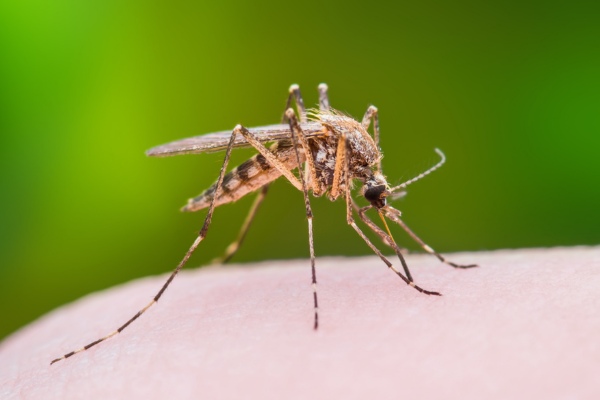- Muỗi cái hút máu người vì trong máu người có protein - một trong những dưỡng chất quan
trọng để tạo ra trứng muỗi. Muỗi cái thường chỉ giao phối một lần nhưng đẻ trứng suốt đời; để thực hiện được chức năng này muỗi cái cần phải đốt máu.
- Còn muỗi đực chỉ hút nhựa cây vì trong đó có chất đường để duy trì vận động mà thôi.
- Khi muỗi cái đốt no máu, chúng tìm nơi trú ẩn để tiêu máu; đó là những nơi kín gió, ấm áp, ẩm thấp và tối tăm. Mỗi loài muỗi
có tập tính tìm nơi trú ẩn khác nhau.
Khi muỗi hoàn thành giai đoạn tiêu máu thì trứng cũng đã chín. Muỗi cái tìm nơi thích hợp để đẻ trứng.
Sau khi đẻ trứng, muỗi lại bay đi tìm mồi hút máu. Thời gian vừa đẻ vừa đi tìm mồi hút máu cho lần đẻ sau được tính
là một ngày đêm. Thời gian muỗi đốt máu, trú đậu tiêu máu, hình thành trứng chín, tìm nơi sinh đẻ và bay đi tìm mồi
đốt máu gọi là chu kỳ sinh thực. Trong điều kiện bình thường, muỗi cái sống khoảng 2 tháng và đẻ trung bình khoảng
6 đến 8 lần. Sau mỗi lần đi đẻ muỗi chết khoảng 50%. Trong phòng thí nghiệm, muỗi sống lâu hơn, có thể tới 3 tháng.
Muỗi đực nuôi dưỡng bằng cách hút nhựa cây, sau khi giao phối chúng sống được một thời gian khoảng 10 đến 15 ngày.
Như vậy muỗi cái sống lâu hơn muỗi đực. Muỗi đực “ăn chay” nên mau chết, còn muỗi cái “ăn mặn” nên sống lâu hơn.

Phân biệt muỗi đực và muỗi cái:
Nói chung muỗi có hình dáng khá nhỏ (chỉ dài khoảng 2 – 3 mm), nên muốn quan sát rõ và phân biệt được con đực, con cái thì phải dùng đến kính lúp. Tuy nhiên, chúng ta có 1 số mẹo nhỏ để phân biệt như sau:
1. Về hình dáng tổng thể: muỗi đực thường có kích thước nhỏ hơn so với muỗi cái.
2. Về cấu tạo: Ở phần đầu của muỗi có hai antena đối xứng ở hai bên chiếc vòi của nó. Trên mỗi antena sẽ có những chùm lông ngắn,
mọc dọc theo antena. Ở con đực, những chùm lông này dài và rậm rạp hơn nhiều so với ở con cái
3. Về thức ăn: muỗi đực chỉ hút nhựa cây và mật hoa để sống qua ngày, một số con muỗi đực sẽ có màu xanh lá cây. Đối với muỗi cái,
trong vòng 3 ngày tuổi, chúng cũng chỉ hút nhựa cây và mật hoa, nhưng sau đó, chúng sẽ cần chất đạm trong máu người và động vật để đẻ trứng,
thực hiện nghĩa vụ “duy trì nòi giống”.
- Female mosquitoes suck human blood because human blood contains protein - one of the important nutrients
important for creating mosquito eggs. Female mosquitoes usually only mate once but lay eggs for life; To perform this function, female mosquitoes need to bite blood.
- Male mosquitoes only suck plant sap because it contains sugar to maintain movement.
- When female mosquitoes bite and are full of blood, they seek shelter to consume blood; These are sheltered, warm, damp and dark places. Every species of mosquito
have different shelter-seeking habits.
When the mosquito completes the blood-digesting stage, the eggs are also ripe. Female mosquitoes look for a suitable place to lay their eggs.
After laying eggs, mosquitoes fly away to find blood to suck. The time spent both giving birth and looking for blood-sucking prey for the next birth is counted
is a day and night. The time mosquitoes bite blood, reside and pepper blood, form ripe eggs, find a place to give birth and fly away in search of prey
Burning blood is called the reproductive cycle. Under normal conditions, female mosquitoes live about 2 months and give birth on average about
6 to 8 times. After each spawning session, about 50% of mosquitoes die. In the laboratory, mosquitoes live longer, up to 3 months.
Male mosquitoes nourish themselves by sucking plant sap. After mating, they live for about 10 to 15 days.
Thus, female mosquitoes live longer than male mosquitoes. Male mosquitoes are "vegetarian" so they die quickly, while female mosquitoes "eat salty" so they live longer.

- How to distinguish between male and female mosquitoes
:
In general, mosquitoes are quite small (only about 2 - 3 mm long), so if you want to clearly observe and distinguish between males and females, you must use a magnifying glass. However, we have a few tips to differentiate as follows:
1. Regarding overall shape: male mosquitoes are usually smaller in size than female mosquitoes.
2. Regarding structure: At the head of the mosquito there are two symmetrical antennae on both sides of its proboscis. On each antenna there will be tufts of short hairs,
grow along the antenna. In males, these tufts of hair are much longer and denser than in females
3. About food: male mosquitoes only suck tree sap and nectar to survive the day, some male mosquitoes will be green. For female mosquitoes,
Within 3 days of age, they only suck plant sap and nectar, but after that, they will need protein in human and animal blood to lay eggs.
fulfill the obligation to "maintain the race".
 Học từ vựng:
- Egg
Học từ vựng:
- Egg:
Trứng
- Larva:
Ấu trùng
- Pupa:
Nhộng
- Adult:
Trưởng thành
- Blood:
Máu
- Microorganisms :
Vi sinh vật
- Molt :
Lột xác
- Pores :
Lỗ chân lông
- Tail :
Đuôi
- Head :
Đầu
- Thorax :
Ngực
- Abdomen :
Bụng

